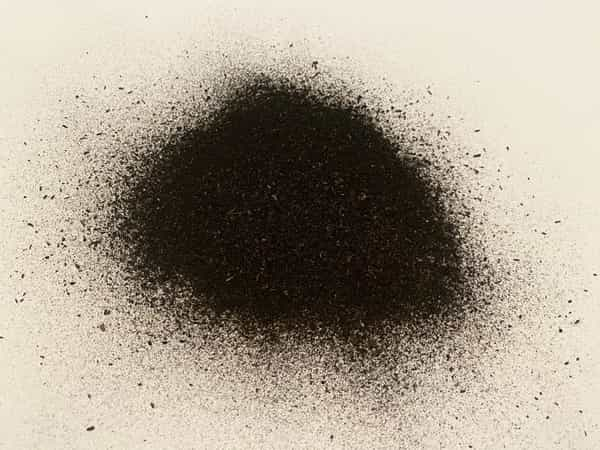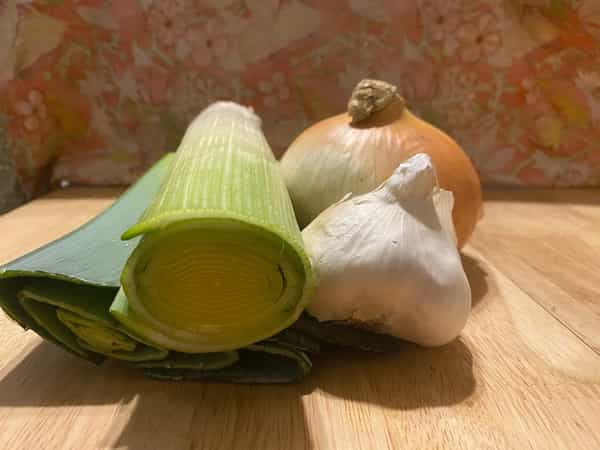In all my culinary career, few techniques offer the depth and complexity that burnt allium provides. Burnt allium is the practice of charring allium family members like onions, garlic, and shallots to unlock their hidden flavors.

As I scrambled to fix my mistake and avoid a stern scolding from my chef, I realized that something (surprisingly) extraordinary had happened. However, I soon discovered that my delicious accident was not as original as I had thought. Seasoned chefs had been practicing the art of intentionally burning onions for generations, dubbing it "burnt allium."
I've found burnt allium to be one of the most intriguing ingredients in my kitchen. Let’s explore the intricacies of crafting leek top charred powder and a delectable burnt onion steak sauce. I will showcase both on a bone-in ribeye “cowboy” steak, an awesome canvas for the robust flavors that arise from taking an onion beyond its usual means.

Burnt Leek Tops Seasoning
Green leek tops (the part usually discarded)
1. Preheat the oven to 500 degrees Fahrenheit and line a baking sheet with aluminum foil to prevent a mess.
2. Rinse the green leek tops thoroughly and pat them dry with a kitchen towel.
3. Cut the leek tops into small pieces. You want them to be relatively uniform in size for even cooking.
4. Spread the cut leek tops evenly on the foil-lined baking sheet. Make sure they are not overcrowded to allow for even charring.
7. Once cooled, grind the burnt leek tops into a fine powder. You can use a spice grinder or a mortar and pestle for this step.
Because the leek powder is completely dehydrated, it will keep at room temperature. Just be sure to store it in an airtight container, preferably not in direct sunlight.
We now turn our attention to a savory masterpiece – a recipe for a flavorful burnt onion steak sauce.
Burnt Onion Steak Sauce Recipe
1 medium Vidalia onion, sliced
1 teaspoon kosher salt
3 cloves garlic, minced
1 cup chicken stock
1/2 cup fresh apple cider
1/4 cup Worcestershire sauce
3 Tablespoons apple cider vinegar
3 Tablespoons dark brown sugar
2 Tablespoons soy sauce
2 Tablespoons Dijon or grainy mustard
2 Tablespoons tomato paste
2 teaspoon chopped fresh thyme
2 teaspoon chopped fresh rosemary
1 teaspoon kosher salt
1 teaspoon ground black pepper
4 oz (1 stick) butter
1. In a medium sauté pan, place the sliced Vidalia onion and season with 1 teaspoon of kosher salt. Heat the pan on high and start blackening the onion flesh, stirring occasionally to achieve even charring. You can add a bit of cooking oil (a few teaspoons) if necessary to prevent sticking.
2. Once the onions are suitably charred, with some tender white parts remaining, add the minced garlic and reduce the heat to medium-low. Stir until the garlic becomes aromatic.
3. Add the following ingredients to the pan: chicken stock, fresh apple cider, Worcestershire sauce, apple cider vinegar, dark brown sugar, soy sauce, mustard, tomato paste, fresh thyme, fresh rosemary, kosher salt, and ground black pepper.
6. Add the butter to the blender in small pieces and blend on high until the sauce has lightened in color, and no butter is visible.
7. If desired, strain the sauce through a fine mesh strainer to remove any residual solid bits.
Store the sauce in an airtight container for up to 7 days. This recipe yields about 2 cups of delicious burnt onion steak sauce. Enjoy!
Now, let's talk about the real fun: tasting our creations. We started with a cowboy ribeye steak, the kind that begs for bold flavors. I generously seasoned the steak with salt, and then came the magic touch – coating it with our unique blackened leek ash. A quick sear and a gentle oven finish later, and we had a perfectly medium-rare steak that was something special. Sliced and plated, it got an extra boost from the rich burnt onion steak sauce.
To learn
